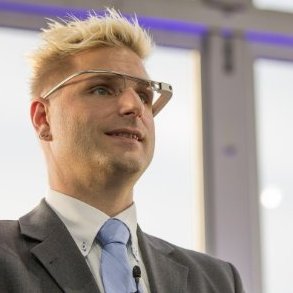
Raimund Gross is a solutions architect and futurist at SAP. He will be traveling from Germany to be a panelist at the “Wearables & Internet of Things” session at the Gilbane Conference in Boston on December 2nd, which is being moderated by Tim Bourgeois of ChiefDigitalOfficer.net.
Question 1: How do you define ‘digital strategy’?
Digital strategy is best when it is a core component of everything else you are doing.
The term digital strategy is a bit of a tautology to me. Looking at the way business is done today I believe the digital part has always to be an integral part of your strategy. On- and offline are already so converged that it is hard – if not even harmful – to separate them in your strategy. The best and most successful examples are when the ‘handover’ from one world into the other works seamlessly.
Gary Hamel once defined strategy-making as an act of innovation. To me, ‘digital strategy’ is about using current and coming digital capabilities to best support your companies’ capabilities and unique traits.
Question 2: What kind of mobile device(s) do you have, and what are your three favorite apps?
To be honest I have too many currently. For work I use a Nexus phone as well as an iPad to keep up with development in both ecosystems [Apple and Android]. Next to that I don’t want to miss my Kindle HD. Less regularly I use the Moto 360 smartwatch, Google Glass, and a BodyMedia FIT LINK Armband.
Although technically not an app, I use my customized Netvibes dashboard to keep-up with the plethora of news sources I consume. For in-depth reading, Instapaper is near and dear to me across all my devices. In addition, I am experimenting with different speed readers (Fastreader, Balto, Spritz) but haven’t found the ideal solution for me so far.
Question 3: What do you think of the emergence of the Chief Digital Officer role?
This role is significant for two reasons:
• Companies perceive a specific need to cover a variety of topics with a dedicated role in contrast to extending already existing roles
• Digital now ‘hits mainstream’ with the advent of a CDO role, mostly found at more ‘traditional’ companies rather than companies that are fully digital by their very nature
As any new technology requires change of mindset and processes, the CDO needs to embrace cross-organizational change-management. It requires a lot of people skills and diplomacy to be successful with that – maybe even more than understanding underlying technologies. Dependent on the enterprise, I see different focus areas of the CDO leading to a very heterogeneous role description. As such, you have to closely look at the context and the circumstances to evaluate and compare the position at different companies.
Question 4: What advice do you have for aspiring digital professionals?
Be curious and open to new experiences, and explore new digital services and offering. Look at ‘regular people’ rather than the digital peer-group. Sharpen your situational awareness to work on your people skills and understand the importance of change-management. After 20 years in IT, I realize that technical concepts keep coming back periodically. Once you understand how people react or resist when faced with change, it will be easier to find ways to jointly work on the way ahead.
Question 5: What are the three most significant digital trends that will define 2015?
Most likely it will be a continuation of topics that started already 2014 — a continued evolution of trends already underway, marked by adoption-at-scale.
With the wide availability of RGB-D camera modules for tablets, and smartphone possibilities for digital 3-d, overlays will open up. Along the same lines, augmented reality concepts will become much more present to users, and therefore an alternative interaction and consumption mechanism for information technology will emerge.
Along the same lines, contextualization and a ‘smart environment’ will tailor and personalize information for the individual even more. This is supported by continued miniaturization of technical components, ubiquity of sensors, and increased analytics and predictive capabilities.
Connect with Raimund on LinkedIn, or meet him in person at his Gilbane Session on December 2nd at 2:40.
